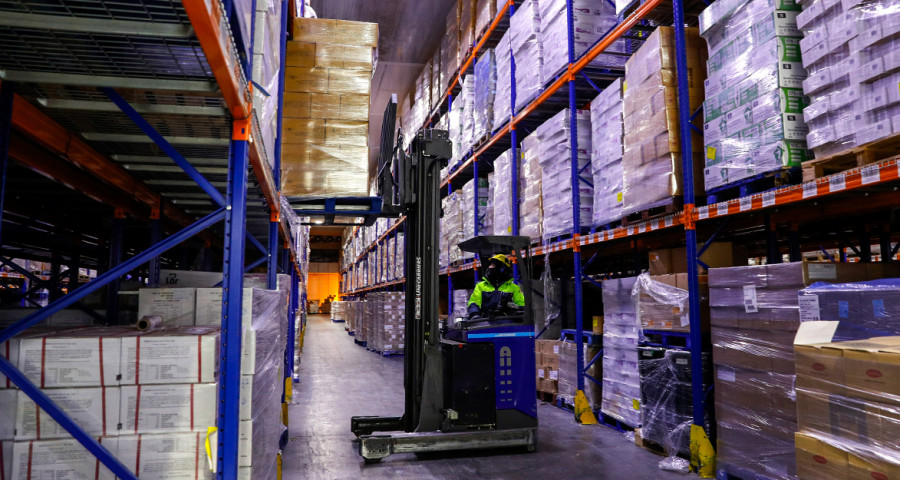

 02.03.2022 07:15 PM
02.03.2022 07:15 PMThe pace of inventory accumulation was, however, slower than in recent months. That, together with the surge in the goods trade deficit, prompted economists at Goldman Sachs to lower their gross domestic product growth estimate for the first quarter by 0.5 percentage point to a 1.5% annualized rate.
The economy grew at a 7.0% pace in the fourth quarter, with inventories contributing a whopping 4.90 percentage points.
"We remain on track for another strong gain in real business inventories in the first quarter, although inventories may end being fairly close to a neutral factor for GDP growth considering that the fourth quarter buildup of inventories also was substantial," said Daniel Silver, an economist at JPMorgan in New York.
The goods trade deficit jumped 7.1% to a record $107.6 billion last month. Goods imports increased by 1.7%, led by food and motor vehicles. There were also large increases in imports of industrial supplies, capital and consumer goods. Imports of other goods, however, tumbled 15.3%.
Exports dropped 1.8%, weighed down by consumer goods, motor vehicles, food and other goods. However, exports of capital goods and industrial supplies increased.
Trade has been a drag on gross domestic product for six straight quarters. Economists saw a limited impact on trade from the Russian-Ukraine conflict, which has resulted in the United States imposing same trade sanctions on Moscow. Russia accounted for only 1% of imports and about 0.4% of exports last year, according to government data.
"While the Russian invasion of Ukraine is driving a sharp increase in energy prices, its implications for trade flows will be less noticeable," said Mahir Rasheed, an economist at Oxford Economics in New York. "Russia and Ukraine make up less than 1% of monthly import volumes and an even smaller share of U.S. exports, so the war has little bearing on the trade outlook."
Meanwhile, a surge in oil prices with a simultaneous abandonment of oil purchases from Russia could lead to increased demand for the US WTI grade, supporting the US trade balance sheet revenue item next year.
During the previous three trading sessions, US stocks were trading lower as investors assessed the fallout from a raft of sanctions imposed by Western countries on Russia. The dollar rose against a basket of currencies. US Treasury yields fell.
However, in the run-up to Fed Chairman Jerome Powell's speech to Congress, markets warmed up a bit and moved upwards.
The increase in imports last month largely reflected the rebuilding of inventories. Stocks at wholesalers increased 0.8% after climbing 2.3% in December. Inventories of durable goods, items which are meant to last three year and longer, rose 1%, while stocks of wholesale nondurable goods climbed 0.5%.
Retail inventories rose 1.9% after jumping 4.7% in December. They were lifted by a 2.4% increase in motor vehicles, which followed a 7% surge in December.
Motor vehicle production remains constrained by a global semiconductor shortage. Excluding motor vehicles, retail inventories gained 1.7% after advancing 3.9% in December. This component goes into the calculation of GDP growth.
Inventory investment increased at a seasonally adjusted annualized rate of $171.2 billion in the fourth quarter, one of the largest in years. Growth estimates for the first quarter range from as low as a 0.6% rate to as high as a 5.4% pace.
"Because of the way GDP is calculated, it would require a similarly sized expansion in inventories to contribute that level of growth," said Matt Colyar, an economist at Moody's Analytics in West Chester, Pennsylvania. "We do not expect the build in the first quarter to exceed the record-breaking fourth-quarter build. As a result, we expect inventories to subtract 0.3 percentage point off GDP growth."
Most economists see further scope for inventories to rise, noting that inflation-adjusted inventories remain below their pre-pandemic level. Inventory-to-sales ratios are also low.
Restocking, after three straight quarters during which inventories were drawn down, is supporting manufacturing.
"The manufacturing sector continues to expand in spite of supply network dislocations and input shortages," Rubeela Farooqi said.
A survey from the Dallas Federal Reserve on Monday showed factory activity in Texas continued to expand in February, though at a slightly slower pace. The survey's production index, a key measure of state manufacturing conditions, dipped two points to a reading of 14.5.
A reading above zero indicates growth in manufacturing in the region. Despite the moderation in activity, factories reported strong growth in new orders and were upbeat about business conditions. The survey's general business activity index shot up 12 points to a reading of 14.0.
Obviously, the geopolitical situation on the other side of the world has so far had little impact on the US economy. Of course, a stronger dollar makes a difference, but the reshaping of the oil markets is likely to work for the US benefit.
主流加密貨幣依然處於分化狀態,難以建立穩固的基礎。比特幣當前正經歷顯著的波動,本週已出現虧損。
S&P 500 指數在最近幾個月中錄得最大單日漲幅之一。上漲的勢頭在5,516附近放緩,但如能突破關鍵阻力位5,669.50,則可能開啟一波新的中期漲勢。
美國股指在白宮宣佈對中國商品進行新一輪關稅後收低。稅率可能升至104%,這對進口商品造成直接打擊,並明確傳遞出貿易緊張局勢將繼續升級的訊息。
在華盛頓意外出手後,全球市場陷入瘋狂:美國對中國商品徵收高達104%的驚人關稅。特朗普總統的決定立即影響了投資者情緒,並引發了一波如同危機的動盪。
特朗普政府最新一輪的關稅正在重塑經濟預期。高盛現預測未來12個月內將出現經濟衰退,而摩根大通的分析師則預測美國GDP增長將減少0.3%。

Your IP address shows that you are currently located in the USA. If you are a resident of the United States, you are prohibited from using the services of InstaFintech Group including online trading, online transfers, deposit/withdrawal of funds, etc.
If you think you are seeing this message by mistake and your location is not the US, kindly proceed to the website. Otherwise, you must leave the website in order to comply with government restrictions.
Why does your IP address show your location as the USA?
Please confirm whether you are a US resident or not by clicking the relevant button below. If you choose the wrong option, being a US resident, you will not be able to open an account with InstaTrade anyway.
We are sorry for any inconvenience caused by this message.

